Epicurean: Making Maldives Merrier
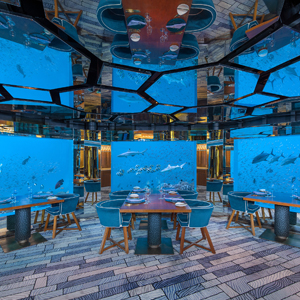
Meet the Indian sommeliers and chefs who are notching up the joy of fine dining in this pristine destination of white sands and turquoise waters.
[Left] The stunning views at SEA Underwater Restaurant.
(Photo: Anantara Kihavah)
Imagine scuba diving into crystal clear blue waters and having your breath taken away by the spectacular, multi-hued flora and fauna of the ocean. Now imagine the same enchanting view cocooning you while you are comfortably seated at a fine restaurant, ready to partake in a sumptuous wining and dining experience. That is what awaits you when you step into the octagonal dining room of SEA Underwater Restaurant—with its massive glass walls overlooking the ocean surrounding it. This award-winning restaurant and wine cellar at Anantara Kihavah, a luxury resort, is situated on the private island of Kihavah Huravalhi in the Maldives.
Arunkumar Tamilselvan is the food and beverage manager as well as the senior wine guru at SEA, which specializes in contemporary European cuisine. He is the only sommelier in the Maldives certified by the Wine & Spirits Education Trust (WSET).
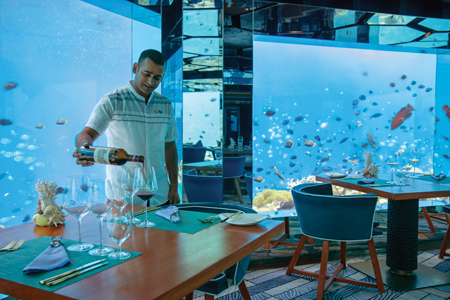 He also holds the Advanced Level Certificate in Sake from WSET. It is remarkable that coming from a conservative background where “no alcohol” was the norm, Arun is now not only an oenophile but also a certified wine educator. His expertise is known far and wide, having worked in a variety of resorts all around the world. He travels to at least one new wine-making country each year to taste and experience their wine.
He also holds the Advanced Level Certificate in Sake from WSET. It is remarkable that coming from a conservative background where “no alcohol” was the norm, Arun is now not only an oenophile but also a certified wine educator. His expertise is known far and wide, having worked in a variety of resorts all around the world. He travels to at least one new wine-making country each year to taste and experience their wine.
[Right] Arunkumar Tamilselvan is the only sommelier in the Maldives certified by the Wine & Spirits Education Trust (WSET).
Arun enjoys the enviable distinction of overseeing the world’s first underwater wine cellar boasting over 450 labels from 17 countries covering all major regions and wine styles. His collection offers all kinds of specialty wines such as organic, bio-dynamic, kosher, vegan, and low-alcohol spirits. Their “Chairman’s Reserve” collection offers old vintages dating as far back as 1795.
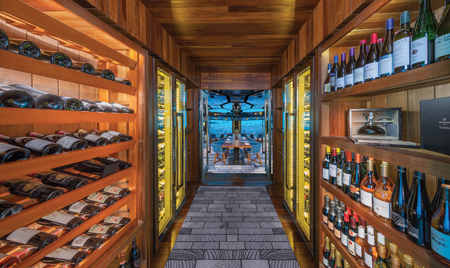
[Left] The first underwater wine cellar offering over 450 labels from 17 countries, including the “Chairman’s Reserve” collection with vintages dating as far back as 1795.
Having a wine-tasting experience at SEA—with Arun’s expertise in guiding and sharing some of the best wines—was unlike anything I had ever had before. Arun’s extensive knowledge is quite evident as he encourages guests to savor the spirits with all the senses while regaling them with stories of each vintage. Be it Gramona Gessami White Wine from Spain, Penfolds Cabernet-Shiraz Bin 389 from Australia, or Tement Morillon Chardonnay from Austria, every sip has a narrative. Of course, the ambiance helps as well. After all, it’s not every day that I get to indulge in wines from around the world while surrounded by coral reefs, sharks, sea turtles, groupers, eagle rays, and schools of clown fish everywhere I turn.
“The Wine and Beverage program at Anantara Kihavah is pretty much autonomous as management has a high level of trust towards me and my team. This gives me the flexibility and creativity I need to try out new initiatives like serving underwater-aged Dom Perignon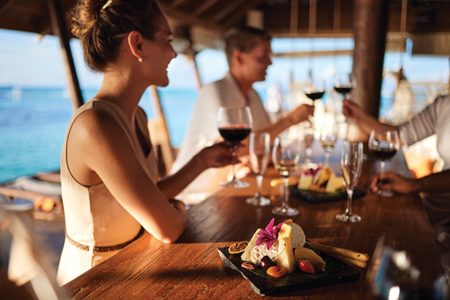 to our guests,” Arun proudly adds. It is the only place in the world to offer Dom Perignon which is aged in Anantara Kihavah’s house reef at a depth of 40 meters for a year. Arun even offers personal recommendations for private wine collectors on how they can stock up on a well-rounded and diverse collection of wine for their personal use.
to our guests,” Arun proudly adds. It is the only place in the world to offer Dom Perignon which is aged in Anantara Kihavah’s house reef at a depth of 40 meters for a year. Arun even offers personal recommendations for private wine collectors on how they can stock up on a well-rounded and diverse collection of wine for their personal use.
[Right] “Having a wine-tasting experience at SEA—with Arun’s expertise in guiding and sharing some of the best wines—was unlike anything I had ever had before.” (Photos: Anantara Kihavah)
Due to its proximity to Sri Lanka and India, there is a strong influence of flavors, spices, produce, and even cooking techniques from these cultures in the Maldives. Like Arun, many of the sommeliers and chefs are from nearby India and have found great success in the Maldives. As wine and spirit experts, they have broken cultural stereotypes and made a name for themselves. The Indian chefs employed in these resorts are changing the rhetoric of traditional Indian cuisines by infusing ingredients, spices, and techniques that are a beautiful mix of all of Maldives’ cultural influences. Prabhash Prabhakaran is the executive chef of all restaurants at Anantara Kihavah. He hails from Kerala, where he learned traditional Indian cooking techniques and culinary secrets from his grandmother and mother. He began his career with Taj Hotels across India, before relocating to Jumeirah Emirates Towers in Dubai and Chedi Muscat in Oman thereafter. “Working alongside Michelin- starred chefs has inspired me to broaden my horizons to encompass multi-regional cuisines that culminate in a marriage of authentic home cooking and fine global flavors,” he notes.
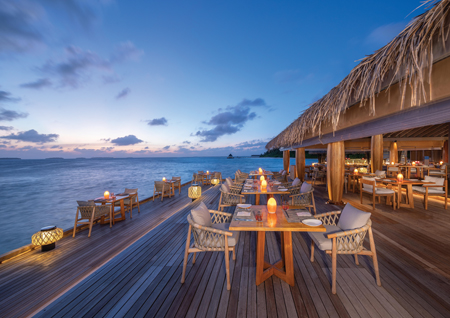
The deck at Spice Restaurant at Anantara Kihavah.(Photo: Anantara Kihavah)
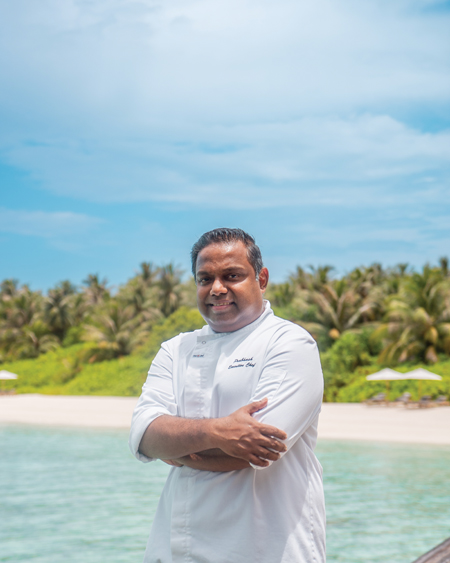
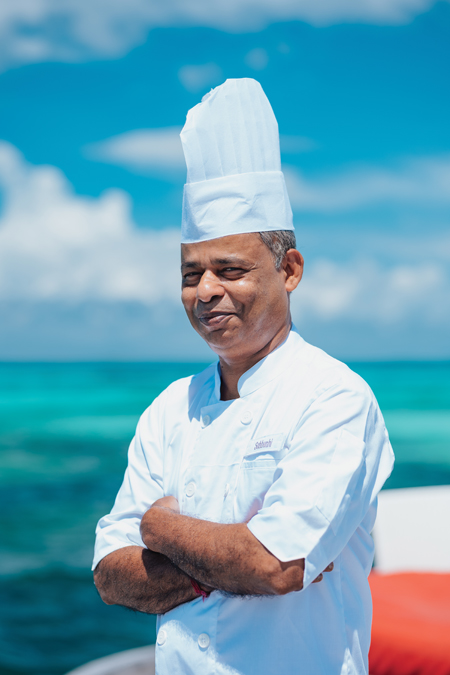
[Left] “Chef Prabhash Prabhakaran has such a jovial and vibrant personality, much like the food he prepares.”
[Right] Chef Subbunhi Banjathadka’s cooking classes are popular at LUX* South Ari Atoll. (Photo: LUX* South Ari Atoll) ( photos: Anantara Kihavah)
Prabhakaran has such a jovial and vibrant personality, much like the food he prepares. He came to our table to chat and regale us with his stories while bringing out dish upon dish of culinary masterpieces. From Papaya Avocado Chaat, Jingha Lassoni Tikka (marinated prawns cooked in tandoor), and Tom Khamint Thalay (flavorful turmeric soup with lemongrass, galangal, and tamarind juice) to a variety of local seafoods, naans, and rice dishes, dinner was an interactive experience. The unexpected combination of flavors, spices, and ingredients was unique and memorable, and gave a whole new twist to Asian haute cuisine— a testament to Chef Prabhakaran’s expertise. “Indian cuisine has so much depth and personality; and being able to share that with guests is very fulfilling.”
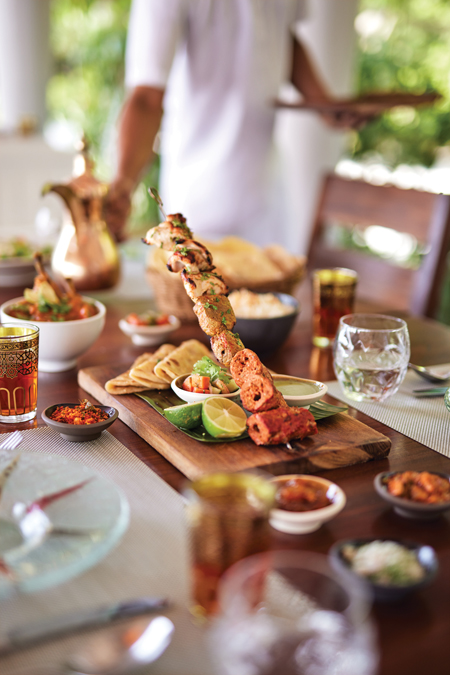
Of course, the wine selection with my meal was superb as well. Arun suggested rosé wine as it makes a fantastic pairing due to its intense aroma as well as refreshing acidity and body. He also brought out aromatic whites such as Muscat, Riesling, and Sauvignon Blanc for the meal because the body and acidity with boosted aromas work well with many Indian foods. “Generally, many sommeliers suggest off-dry white wines with Indian foods, and it does work for many curries and spicy flavors, but I believe it’s time to try something new,” he adds. However, if you prefer reds like me, don’t fear. Red wines range from light-bodied and aromatic with soft tannin to full-bodied and well-ripened with high tannin, and from subtle fruity notes to fully ripened, often over-ripe, fruit characters and alcohol levels. Per Arun, this does make them ideal for many rich, complex Indian foods. “Pinot Noir and Merlot can be paired well with dishes like Chicken Malai Kebab, Dal Makhani, and Shahi Paneer. Garnacha, Sangiovese, and Tempranillo often pair well with Tandoori Chicken, Madras Fish Curry, and Kerala Prawn Curry. Cabernet Sauvignon, Syrah/Shiraz, Malbec, Nebbiolo, and Amarone are suitable for heavily rich Indian dishes such as Chicken Tikka Masala, Biriyani, Mutter Paneer, and Spicy Rogan Josh,” he suggests.
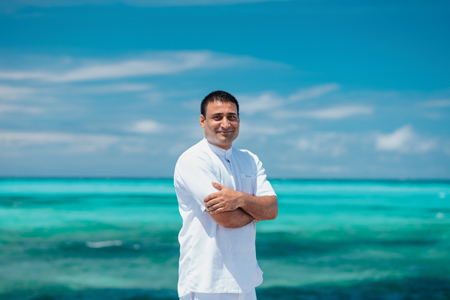
[Top] Enticing kebabs at Senses Food at LUX South Ari Atoll.
[Left] One of Sommelier Sumeet Kumar’s favorite is “an Australian chardonnay for the golden saffron risotto garnished with gold leaf.” (Photos: LUX* South Ari Atoll)
And if you want to be adventurous and experiment with your choice of spirits, Arun is more than happy to suggest sake. Sake has a lot more to offer to foodies, from sparkling or still, from lightly aromatic Ginjo style to more robust Honzojo and Futsu-shu style. “In my point of view, sake can be paired with a lot of foods. Asian food in general can be well paired with sake as they came from the same cultural roots. As someone who hails from India, I would love for Indian foods to be more experimented in combination with sake.” Together, Prabhakaran and Arun create a truly immersive dining experience.
In the southern Maldivian atoll lies another luxury resort, LUX* South Ari Atoll, where both the senior sous chef and the sommelier are Indians. Chef Subbunhi Banjathadka, also from Kerala, started his journey in the hospitality industry in India while working with numerous luxury brands in Kannur and Kasaragod. He joined LUX* South Ari Atoll as commis chef back in 2008 and now, 15 years later, has become the senior sous chef. He offers an eclectic mix of dining themes—a tandoori BBQ lunch with freshly grilled treats from the traditional tandoori oven, a Maharaja Night-themed dinner accompanied by regional delicacies, a special Diwali dinner that celebrates festival flavors, and many more.
Chef Banjathadka’s cooking classes are popular. I, along with a group of other enthusiastic guests, learned how to make Bis Keemiya (a cousin of the Indian samosa), a cabbage and coconut salad that reminded me of Chettinad-style cabbage poriyal, and Anbu Riha, a curry with tuna, mango, coconut, and hot chilis.
Sommelier Sumeet Kumar is from Himachal Pradesh. Across his 13-year long Food & Beverage career, Sumeet has worked with several renowned hotel brands, including Taj Hotels, Royal Orchid Hotels, and Trident Hotels. Following his dream to work in the Maldives, he joined as a bartender in 2017 and is now the resident sommelier. “The process of creating cohesion around food and wine is a joint effort by the culinary teams here. The main goal is to create an unforgettable bond woven through authentic dishes, wine dinners, and wine-tasting journeys,” says Sumeet. He personalizes wine menus for guests based on their dining and drinking habits. “Some of my favorites are a French champagne to go with that hand-cut marinated Angus beef carpaccio with truffle cream and truffle dressing, or an Australian chardonnay for the golden saffron risotto garnished with gold leaf,” shares he. “I truly enjoy sharing my passion and knowledge around wines with guests because I want them to connect with where they are and what they are doing in every possible way. Good food, great wine, and beautiful ambiance go hand in hand in making the whole dining experience extraordinary.”
A trip to the Maldives is quite magical in so many ways. But for me, it was a real thrill to see fellow Indians not only living here but also thriving and preserving the cultural identity of India’s connection to the Maldives through all aspects of the culinary arts.
Karthika Gupta, originally from Mumbai, is a travel writer and photographer based in Chicago, Illinois. Her work focuses on travel, culture, and lifestyle narratives from around the world. She can be reached at karthika@karthikagupta.com
A beach paradise that is also a confluence of cultures
My first glimpse of the turquoise waters around the Maldives left me breathless. As my seaplane took off from Male, the capital of Maldives, and headed towards Muravandhoo Island in Raa Atoll, the scenery just intensified. No wonder this island nation is a dream destination for so many. Images of picture-perfect bungalows that open to blue waters, palm trees contrasting against clear skies, and white sandy beaches flood travel magazines and guidebooks.
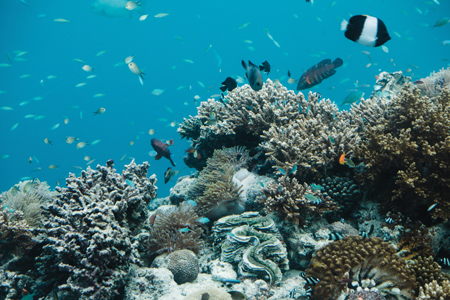
Among the 1200 islands in the Maldives ecosystem, more than 150 are designated for tourism with large self-sustained resort communities like the ones I visited. However, this island nation, roughly 400 to 500 miles from India and Sri Lanka, is so much more than a tourist hotspot. Culturally rich, Maldives has been a haven for migrants from India, Sri Lanka, and even Arabia— all of whom have shaped its present day.
The Maldives archipelago has been inhabited since around the fifth century B.C. Archeological evidence suggests that the early settlers were Buddhists, but Islam took over much of the islands in the twelfth century when Arab influence from nearby India became more prominent. Over the shifting of power during the next several hundred years, many different nations like England and Netherlands established colonies here because of its location along one of the main marine routes in the Indian Ocean. In 1965, Maldives gained independence from the United Kingdom and today, the country remains a presidential democracy.
I consider myself incredibly lucky to have experienced the best of what Maldives has to offer. At Joali, a luxury resort in Raa Atoll, an underwater paradise beckoned just a few feet from my beach bungalow. A morning snorkel was the perfect way to start the day with fish and coral all around me. At Anantara Kihavah, I snorkeled in their house reef. It was teeming with fish of all colors and some of the healthiest coral I have seen. At South Ari Atoll, I even had a chance to participate in a coral planting session with their resident marine biologist who explained how coral planting and coral farming are great ways to promote regeneration and educate guests on the plight of reefs in the Maldives.
Another popular activity among tourists is visting Hanifaru Bay Biosphere Reserve in Baa Atoll, one of the world’s largest manta ray feeding locations. Swimming with these gentle giants as they floated by was a pinchme- moment for sure. If you are a diver, there are many programs at almost all the resorts. The waters around the Maldives are considered among some of the best places to dive in the world, per DIVE Magazine.
While here, don’t forget to experience some of the wellness programs provided. There is something incredibly rejuvenating and restorative about getting a massage surrounded by endless ocean views, calm waters, and colorful fish swimming beneath you, thanks to over-water treatment rooms.
Enjoyed reading Khabar magazine? Subscribe to Khabar and get a full digital copy of this Indian-American community magazine.
blog comments powered by Disqus










